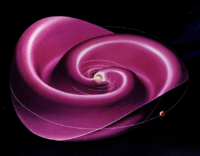Interplanetary magnetic field
The interplanetary magnetic field (IMF) is the term for the solar magnetic field carried by the solar wind among the planets of the Solar System.

Since the solar wind is a plasma, it has the characteristics of a plasma, rather than a simple gas. For example, it is highly electrically conductive so that magnetic field lines from the Sun are carried along with the wind. The dynamic pressure of the wind dominates over the magnetic pressure through most of the solar system (or heliosphere), so that the magnetic field is pulled into an Archimedean spiral pattern (the Parker spiral) by the combination of the outward motion and the Sun's rotation. Depending on the hemisphere and phase of the solar cycle, the magnetic field spirals inward or outward; the magnetic field follows the same shape of spiral in the northern and southern parts of the heliosphere, but with opposite field direction. These two magnetic domains are separated by a two current sheet (an electric current that is confined to a curved plane). This heliospheric current sheet has a shape similar to a twirled ballerina skirt, and changes in shape through the solar cycle as the Sun's magnetic field reverses about every 11 years.

The plasma in the interplanetary medium is also responsible for the strength of the Sun's magnetic field at the orbit of the Earth being over 100 times greater than originally anticipated. If space were a vacuum, then the Sun's magnetic dipole field, about 10−4 teslas at the surface of the sun, would reduce with the inverse cube of the distance to about 10−11 teslas. But satellite observations show that it is about 100 times greater at around 10−9 teslas. Magnetohydrodynamic (MHD) theory predicts that the motion of a conducting fluid (e.g. the interplanetary medium) in a magnetic field, induces electric currents which in turn generates magnetic fields, and in this respect it behaves like a MHD dynamo.
